When oceans cover more than 71% of our planet and are our main long-term carbon sink, their presence is hard to ignore in the fight for climate justice. And when your entire life is spent on an island surrounded by rapidly encroaching sea, it’s even harder.
This year’s theme for World Oceans Day, “Gender and the Ocean”, gives us an opportunity to reflect on the gender dimension of our relationship with the ocean. As a Pacific Island woman raised in the middle of the world’s largest ocean (larger than the landmass of all the continents combined), I was surrounded by a multitude of roles in ocean spaces. We were raised believing the sea would always sustain us, only to now be confronted by the fact that it could one day swallow us.
The science is clear. Last year’s IPCC special report on Global Warming of 1.5ºC highlighted the impacts that increasing atmospheric CO2 could have on human and natural systems – particularly the ocean. Sea level rise and storms threatening coastal communities, increased ocean acidity and turbidity disrupting ecosystems, and increasing ocean temperatures causing mass coral bleaching events worldwide. These are only a few of the threats that anthropogenic climate change poses to our big, blue planet.
So what does this have to do with gender? In ocean spaces where women already earn only 64% of men’s wages in the aquaculture industry and make up only 2% of the 1.2 million seafarers worldwide, a dying ocean is not what we need. Women account for only 30% of the world’s researchers, and female representation in the field of marine science and ocean research is particularly rare. And yet, women and children are 14 times more likely to be injured in disastrous climate impacts than men.
All of these figures represent what already exists in the climate crisis: injustice and vulnerability. And yet, that is not what comes to mind when reflecting on “Gender and the Ocean”, particularly in the context of women in the Pacific. Instead, we are drawn to their constant journeys of empowerment, inspiration and potential. Through their involvement in coastal fisheries, women in the Pacific contribute more than 80% of household and village protein requirements. In Fiji, women go beyond fishing and gathering – playing an important role in the sale of seafood in municipal markets.
Aside from the fisherwoman and feeder, the Pacific woman’s role in ocean spaces is vibrant and versatile. I am constantly inspired by women making waves in the world’s largest ocean, even in the face of a climate breakdown.
Dr. Hilda Heine, President of the Republic of the Marshall Islands
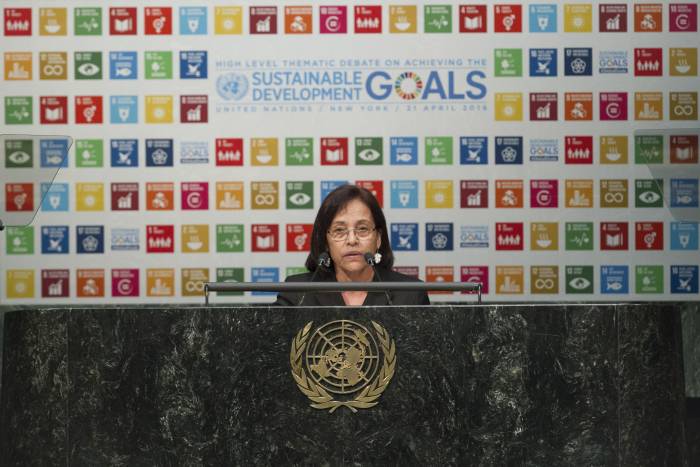
Dr. Hilda C. Heine, President of the Republic of the Marshall Islands. ©UN Photo/Manuel Elias
Dr. Hilda Heine has broken glass ceilings for women all across the Pacific, as the first woman to lead an independent Pacific Island nation. She has continued to champion climate justice on a global scale with the Marshall Islands committing to go carbon neutral by 2050. They plan to adopt new shipping technologies that could have ripple effects across the international sector. In the face of climate impacts that we had very little role in causing, Dr. Heini is a constant reminder of the spirit behind the Pacific Climate Warriors mantra, “We are not drowning, we are fighting.”
Aunofo Havea
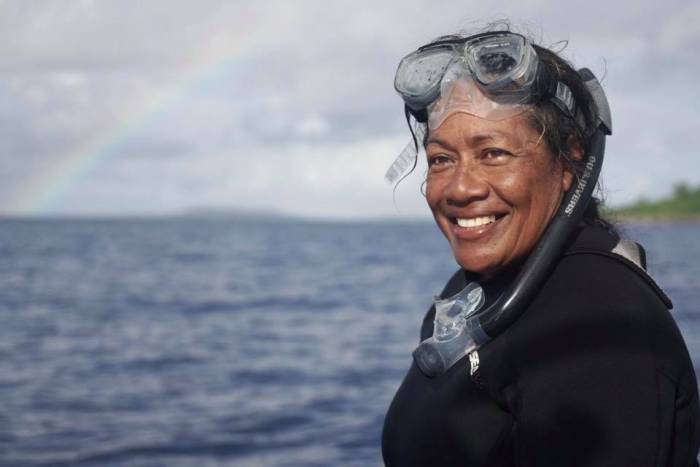
Captain Aunofo Havea. Photo: Lawrence Curtis
I have been lucky enough to sail with Captain Aunofo Havea, Tonga’s only female yacht and kalia (traditional voyaging vessel) captain. She has been a champion of sustainable tourism, working as Tonga’s first female whale watching captain as well. The impact that a warming ocean has on the Pacific’s tourism industry is apparent in the disruption of habitats, migration patterns and ecosystems. When I sailed with Aunofo, she was captain of a traditional Polynesian voyaging vessel – sustainably wind-powered and reminiscent of the indigenous knowledge that holds many of the solutions needed in today’s climate crisis.
This World Oceans Day, Aunofo was invited to speak at the United Nations on her role as a traditional sea captain. In a field dominated by both males and fossil fuels, Aunofo inspires young Pacific women to step BACK into their history for sustainable indigenous maritime solutions, and then FORWARD towards pushing the gender gaps in new frontiers.
Dr. Elizabeth Holland
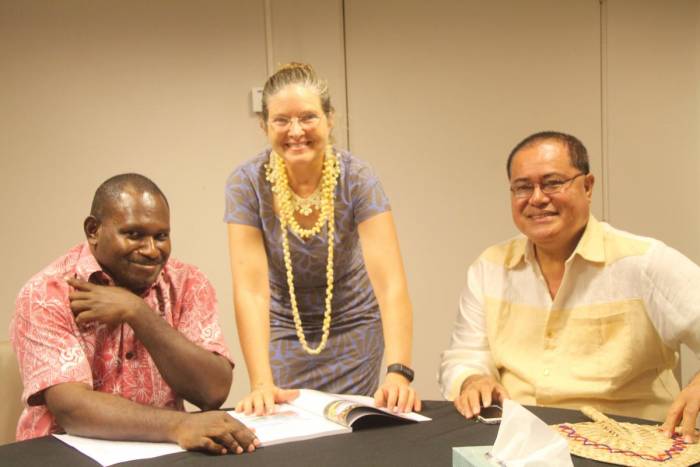
Professor Elisabeth Holland (centre). Photo: PaCE-SD
Dr. Holland is the current Director of the University of the South Pacific’s Centre for Environment and Sustainable Development. She has long been a champion of climate solutions “by the Pacific for the Pacific.” You may have noticed that the word “oceans” was only named once in the text of the Paris Agreement, despite how important they are in the global climate system. Dr. Holland was a key part of ensuring the Ocean Pathway was a part of COP23, to ensure the ocean featured more prominently in negotiations. To all those that studied under her and worked alongside her, Beth is an example of the importance of women in climate and marine research in order to further an inclusive and holistic climate movement.
Kathy Jetnil-Kijner
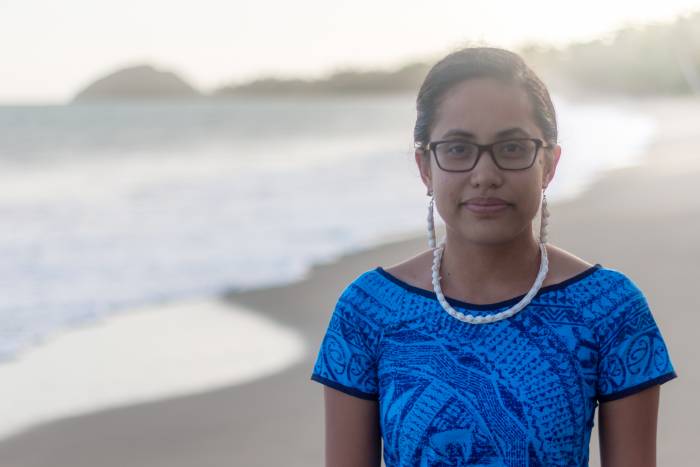
Pacific Climate Warrior and poet, Kathy Jetnil-Kijner. Photo: 350 Pacific
The Marshallese poet, performer and educator has woven stories of the Pacific into her quest for climate justice. She is a well known face in the 350 Pacific Pacific Climate Warriors and co-founder and director of Jo-Jikum, a non-profit focussed on community organizing in the Marshallese youth climate movement. Marshall Islands is one of the most vulnerable Pacific countries to further climate change and are part of the Coalition of Low Lying Atoll Nations on Climate Change. Any young Pacific woman in the climate movement has seen or heard the echoes of their ancestors in Kathy’s poetry, demanding that the world sit up and listen to islands being eaten by ocean. Seas that our ancestors navigated across by the stars are now the seas chewing at the shores of atolls, and Kathy’s work such as Rise: From One Island to Another has played a major role in healing many hearts, angry of this injustice and burning with the rage to change it.
Ana Vakamisinari
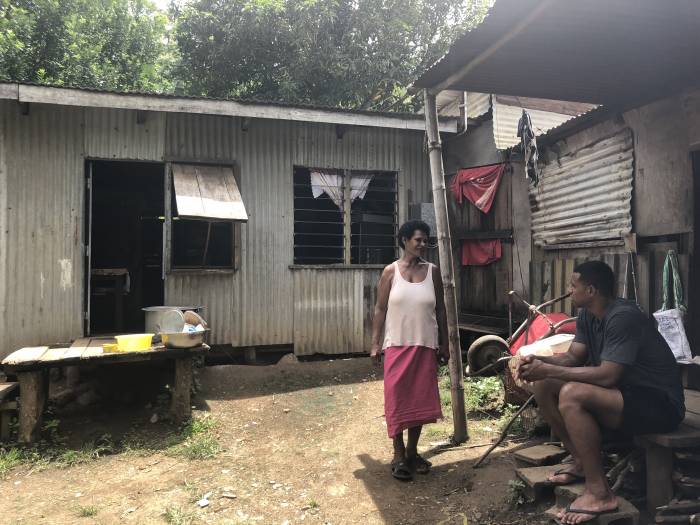
Ana Vakamisinari at her home on the coast of Viti Levu
Ana is the woman that spends her days in the lagoon fishing for her family. She is also the woman that spends her nights in the mangroves catching mudcrabs for her roadside stall. Originally from the island of Kadavu, Ana now lives in a coastal settlement on Fiji’s largest island, Viti Levu. She and her family have fought off developers and live-rock harvesting in order to thrive along the shoreline. Coastal Fijian villages rely heavily on the health of coral reefs and inshore fisheries – both of which are succumbing to increased ocean temperatures and low pH levels. But women like Ana Vakamisinari adapt and evolve their methods in order to not only feed their families, but to share resources with neighbouring households (like my own) and simultaneously make a living off of their catch.
These are only a few of the women that have inspired me and many others in the voyage for climate justice as Pacific Islanders. We live on a blue planet and the oceans are a key part in ensuring a safe and secure climate for generations to come. In the words of marine biologist and explorer Sylvia Earle, “No water, no life. No blue, no green.”